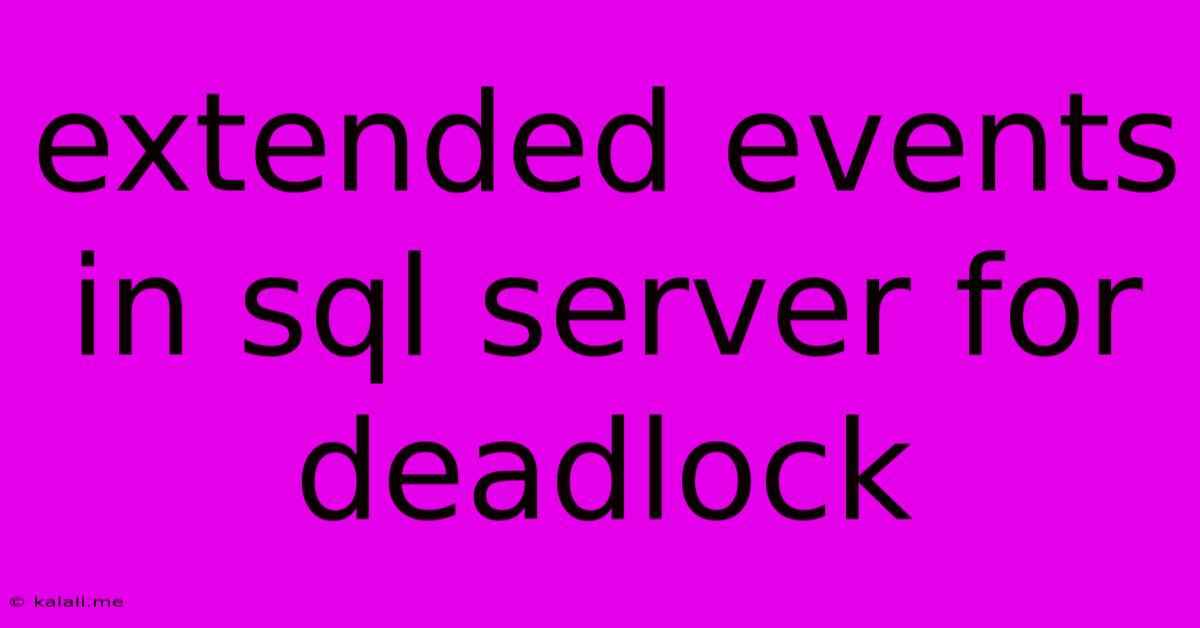Extended Events In Sql Server For Deadlock
Kalali
Jun 04, 2025 · 4 min read

Table of Contents
Leveraging Extended Events in SQL Server for Deadlock Troubleshooting
Deadlocks are a common and frustrating problem in SQL Server databases, leading to blocked transactions and impacting application performance. While SQL Server provides the sys.dm_exec_deadlocks dynamic management view (DMV) for viewing deadlock information, it offers limited detail and historical context. This is where Extended Events (XEvents) shine, offering a powerful and flexible way to capture comprehensive deadlock information, enabling more effective troubleshooting and preventative measures. This article will guide you through effectively utilizing Extended Events to diagnose and resolve SQL Server deadlocks.
Understanding Deadlocks and Their Impact
A deadlock occurs when two or more transactions are blocked indefinitely, waiting for each other to release resources. This creates a standstill, preventing further progress until the deadlock is resolved by SQL Server, typically by rolling back one or more transactions. The impact can range from minor performance hiccups to significant application outages, depending on the severity and frequency of the deadlocks. Identifying the root cause is crucial for remediation.
Why Extended Events are Superior for Deadlock Analysis
While sys.dm_exec_deadlocks provides a snapshot of the deadlock, it's limited by its immediate nature. Extended Events offers several advantages:
- Detailed Information: XEvents capture far richer information about the deadlock, including the exact statements involved, wait statistics, and resource contention details.
- Historical Data: XEvents allow you to record deadlock events over time, enabling analysis of recurring patterns and identifying problematic queries or application logic.
- Customizable Events: You can configure XEvents to capture only relevant information, filtering out unnecessary data for easier analysis.
- Performance Impact Minimization: While XEvents do have some performance overhead, careful configuration minimizes this impact, making them a practical solution for ongoing monitoring.
- Integration with other tools: XEvents data can be easily exported and analyzed using tools like SQL Server Profiler or third-party monitoring solutions.
Setting up Extended Events for Deadlock Monitoring
Creating an Extended Events session for deadlock monitoring involves several key steps:
-
Creating the Session: Use T-SQL to define a new session. You'll need to specify the target (e.g., a ring buffer, file, or a SQL Server trace), and importantly, include the
sqlserver.deadlock_chainevent. -
Filtering Events (Optional): For larger databases, filtering events can reduce the volume of data collected, improving performance. You can filter by database name, session ID, or other relevant criteria.
-
Starting and Stopping the Session: Once the session is configured, start it. Remember to stop the session when you've collected sufficient data or when it's no longer needed to avoid unnecessary disk space consumption.
-
Analyzing the Data: Once the session is stopped, you can review the collected data. The information contained within the
sqlserver.deadlock_chainevent will provide detailed insights into the transactions, locks, and resources involved in the deadlock. This detail is significantly more granular than the information provided bysys.dm_exec_deadlocks.
Interpreting Extended Events Data for Deadlock Resolution
The key to resolving deadlocks lies in understanding the information provided by the sqlserver.deadlock_chain event within your Extended Events session. Focus on:
- The involved transactions: Identify the specific queries or stored procedures involved in the deadlock.
- The resources being contested: Pinpoint the tables, rows, or other resources causing contention.
- The wait graph: Analyze the wait graph to understand the dependency chain between the blocked transactions.
- Execution plans: Examine the execution plans of the involved queries to identify potential performance bottlenecks that might contribute to deadlocks.
By analyzing this detailed information, you can identify the root cause of the deadlock and implement solutions, such as:
- Optimizing queries: Improve query performance to reduce contention for resources.
- Modifying application logic: Change the order of operations or the way resources are accessed to prevent deadlocks.
- Adjusting transaction isolation levels: Choosing a suitable isolation level (e.g.,
READ UNCOMMITTED) can help in specific scenarios but should be approached cautiously due to potential data inconsistency. - Adding indexes: Ensure appropriate indexing to speed up data access and minimize lock contention.
Conclusion:
Extended Events provide a superior alternative to sys.dm_exec_deadlocks for diagnosing and resolving deadlocks in SQL Server. By leveraging the detailed information and historical context provided by XEvents, database administrators can effectively identify recurring patterns, pinpoint root causes, and implement targeted solutions to prevent future deadlocks and improve database performance. Remember that proactively monitoring for deadlocks and regularly reviewing Extended Events data is key to maintaining a healthy and efficient SQL Server environment.
Latest Posts
Latest Posts
-
Google Apps Script Round To Nearest Number
Jun 05, 2025
-
Best Spring Break Locations In Us
Jun 05, 2025
-
When To Use Bell Trap Floor Drain
Jun 05, 2025
-
3 Way Motion Detector Light Switch
Jun 05, 2025
-
Clean Animals And Unclean Animals In The Bible
Jun 05, 2025
Related Post
Thank you for visiting our website which covers about Extended Events In Sql Server For Deadlock . We hope the information provided has been useful to you. Feel free to contact us if you have any questions or need further assistance. See you next time and don't miss to bookmark.